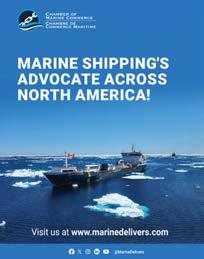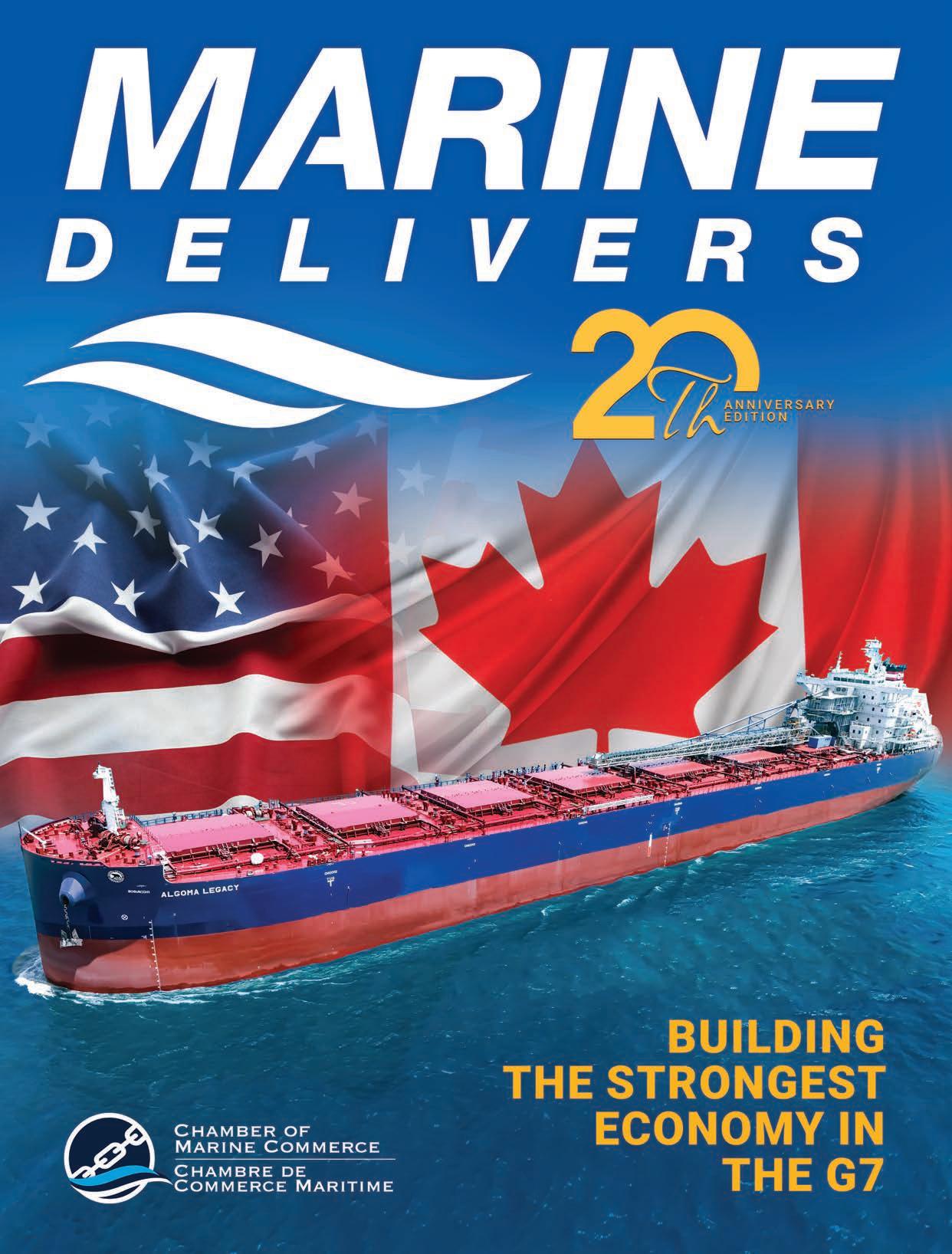














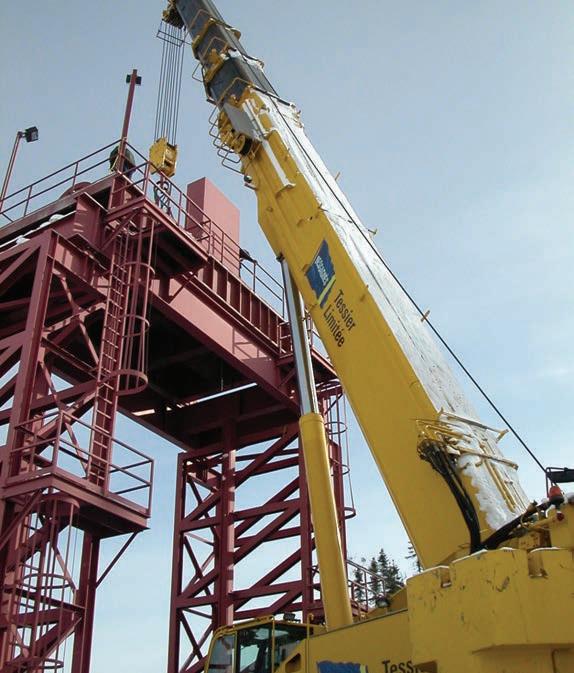



























From steel and cement to grain and petroleum, Algoma delivers the cargo that propels North America’s economy.
Our diversified fleet of dry and liquid bulk carriers provides safe, reliable, and efficient marine transportation across the Great Lakes–St. Lawrence Seaway and Atlantic Canada, bolstering supply chain resilience, keeping commerce moving, and supporting vital industries so they can provide critical raw materials at home and for export to global markets.
MAGAZINE
PUBLISHER
Chamber of Marine Commerce
EDITORS
Jason Card and Leo Ryan
MARKETING AND BUSINESS DEVELOPMENT
CONSULTANT
Sophie Belina Brzozowska
DESIGN & LAYOUT
SPIN Visual Communications
www.spinvisual.com
EDITORIAL OFFICE
300 Sparks Street
Place de Ville
Podium Building, Suite 340 Ottawa, Ontario, K1R 7S3 CANADA
Tel. 613-233-8779
COVER PHOTO
The cover image features “The Algoma Legacy,” a methanol-ready, self-unloading bulk carrier that is the first of three new vessels and the 100th ship to join the global fleet of Algoma Central Corporation. This advanced vessel is a key part of the company’s sustainable growth, and is designed to be 40% more efficient.





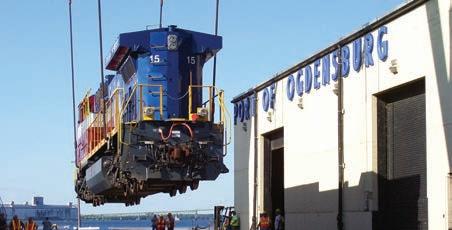
marine highway straight into the industrial heartland of North America. Strategically located, Highway H 2O provides shippers with easy access to a more direct route that delivers
Make your over-dimensional worries a thing of the past.
Our System provides a safe and reliable transit for your heavy-lift and Highway H2O provides the dependability you need to keep your products moving and your clients happy. A fresh clean approach to your transportation needs. For more information, please visit www.hwyh2o.com Water way to go! www.hwyH2O.com

FROM THE PRESIDENT AND CEO

JOSHUA H. JUEL PRESIDENT AND CEO CHAMBER OF MARINE COMMERCE
The President and CEO role at the Chamber of Marine Commerce counts among the 360,000 jobs supported by our inland and coastal marine industry. Having spent my entire professional life in transportation, I have come to know many hardworking, profoundly dedicated, and talented individuals – frankly, many of the unsung heroes – that keep our ships and cargoes moving on our inland and coastal waterways. Each one of those people plays a role in driving critical North American commerce. As part of the team at the CMC, I look forward to elevating the visibility of this vital work and likewise getting to know (and learn from) more of you. Together, as CMC, we will continue to skillfully advocate on issues that are not only important to our industry, but also to the economic security of two great nations and allies: Canada and the United States.
The ability to adapt, improvise, and endure are hallmarks of marine transportation, and those qualities will see us through in these dynamic times – as they have in the past. Over the last two decades, Marine Delivers has chronicled some of the most significant developments in our marine shipping industry, including innovative feats in logistics and the impacts of ever-evolving economies. This issue is no different. For this 20th Anniversary edition, you will find compelling stories of an industry that is fundamentally united, visionary, and ready to respond to new global economies, whilst never losing sight of our commitment to safe, reliable, and sustainable shipping in North America.
In this edition you will see….
A Message from the Honourable Steven MacKinnon, Minister of Transport and Leader of the Government in the House of Commons in which he emphasizes the Federal Government’s commitment to work with the marine industry to drive economic success.
An in-depth conversation with Jim Athanasiou, President and Chief Executive Officer of the St. Lawrence Seaway Management Corporation, in which he discusses his vision for strengthening the Seaway’s role in supporting trade across North America by increasing capacity, enhancing reliability, and improving infrastructure.
An overview of the St. Lawrence and Great Lakes Leadership Roundtable that took place in September, assembling close to 100 leaders in the inland and coastal marine shipping industry to chart the way forward to strengthen shipping on the Great Lakes and St. Lawrence Seaway.
An interview with Mayor of St. Catharines Mat Siscoe, who emphasizes the vital need for the Canada Border
Services Agency to enable more ports to receive foreign containers, as this would strengthen supply chains, enhance global competitiveness, and support growth in communities throughout the Great Lakes.
A CMC member spotlight on Leslie Drynan, General Manager of the Port of Johnstown, which explores how the collaborative and community-focused approach she has established in her first year of leadership is supporting local engagement and regional economic development.
A look at how global ports are increasingly forming strategic alliances to boost trade, sustainability, and innovation, with a focus on recent collaboration among five ports on the St. Lawrence: Montreal, Quebec, Trois Rivières, Saguenay, and Sept-Îles.
Thoughts about cross-border trade from Earl Provost, Ontario AgentGeneral in Chicago, and insights into the Government of Ontario’s vision for greater Ontario-U.S. engagement.
BMO Financial Group’s Chief Economist Douglas Porter’s outlook for the North American economy at a time when global trade relationships are evolving rapidly.
The common thread is again, people. Their efforts each contribute to the success of our shared waterways, which provide the foundational goods upon which our society is based. Innovation, partnership, and cost-effectiveness without compromising either quality or safety are recurring themes. We look forward to sharing more stories about the tremendous work done by those in our industry and increasing awareness of how these efforts safeguard business and consumer interests in North America.
I hope you enjoy this special 20th Anniversary edition, and I am excited to serve alongside you as we face our many opportunities ahead!
For over a century, Parrish & Heimbecker has been shaping the future of Canadian grain. Today, we’re expanding that legacy by building one of Canada’s most robust and responsive terminal networks. With strategic investments across the Great Lakes and St. Lawrence, P&H is becoming a leading force at Canadian ports. We’re ready to serve vessel owners, collaborate with marine stakeholders, and deliver exceptional throughput when and where it matters most.
From the Prairies to portside, we’re growing to move grain efficiently and reliably for generations to come.


THE HONOURABLE
STEVEN MACKINNON MINISTER OF TRANSPORT AND LEADER OF THE GOVERNMENT IN THE HOUSE OF COMMONS
Marine shipping is at the core of Canada’s economic strength, keeping the country connected through inland and coastal routes, and supporting Canada’s goal of building the strongest economy in the G7. More than $66 billion in economic activity across North America is supported annually by commerce transiting the binational St. Lawrence Seaway, lock, and coastal system, employing nearly 360,000 people in Great Lakes, coastal, and Arctic operations.
The Great Lakes-St. Lawrence Seaway system is one of the world’s major trade arteries. In addition to supporting our current international trade, now, more than ever, we rely on it to enable increased internal trade and advance the nation-building projects that will shape Canada’s future. Over 252 million tonnes of vital cargo, such as agricultural products, steel, and construction materials, move through the Great Lakes, Atlantic, and Arctic marine corridors each year. These shipments are essential to the lives of Canadians and to the competitiveness of Canadian businesses at home and abroad.
Industry and government must work together to build a resilient and efficient supply chain. We have modernized trade infrastructure, helped make marine corridors more efficient, and improved the resilience of trade corridors. Federal initiatives to drive the adoption of lowcarbon and clean fuels are also creating momentum for greener, more sustainable marine shipping.
Through initiatives such as the Green Shipping Corridor Program, we are supporting the advancement of clean technologies and sustainable practices that reduce marine emissions and protect our waterways for future generations.
Canada’s marine network is a transportation system and a community of dedicated professionals whose work fuels our economy. The members of the Chamber of Marine Commerce are key partners, helping ensure that marine shipping continues to connect Canada to the world, and keep goods moving efficiently to people who rely on them.
Thank you for your commitment and leadership. I look forward to working with you as we continue building a strong, sustainable, and prosperous future for Canadians.

Engaged directly in shaping the destiny of the Canadian section of the key binational maritime corridor, Demetrios (Jim) Athanasiou shared his views on how the SLSMC is navigating challenges and finding opportunities in today’s unique global environment. Some crucial components he singled out for building a bright future are innovation and strong collaboration between the Canadian and U.S. Seaway authorities.
BY LEO RYAN
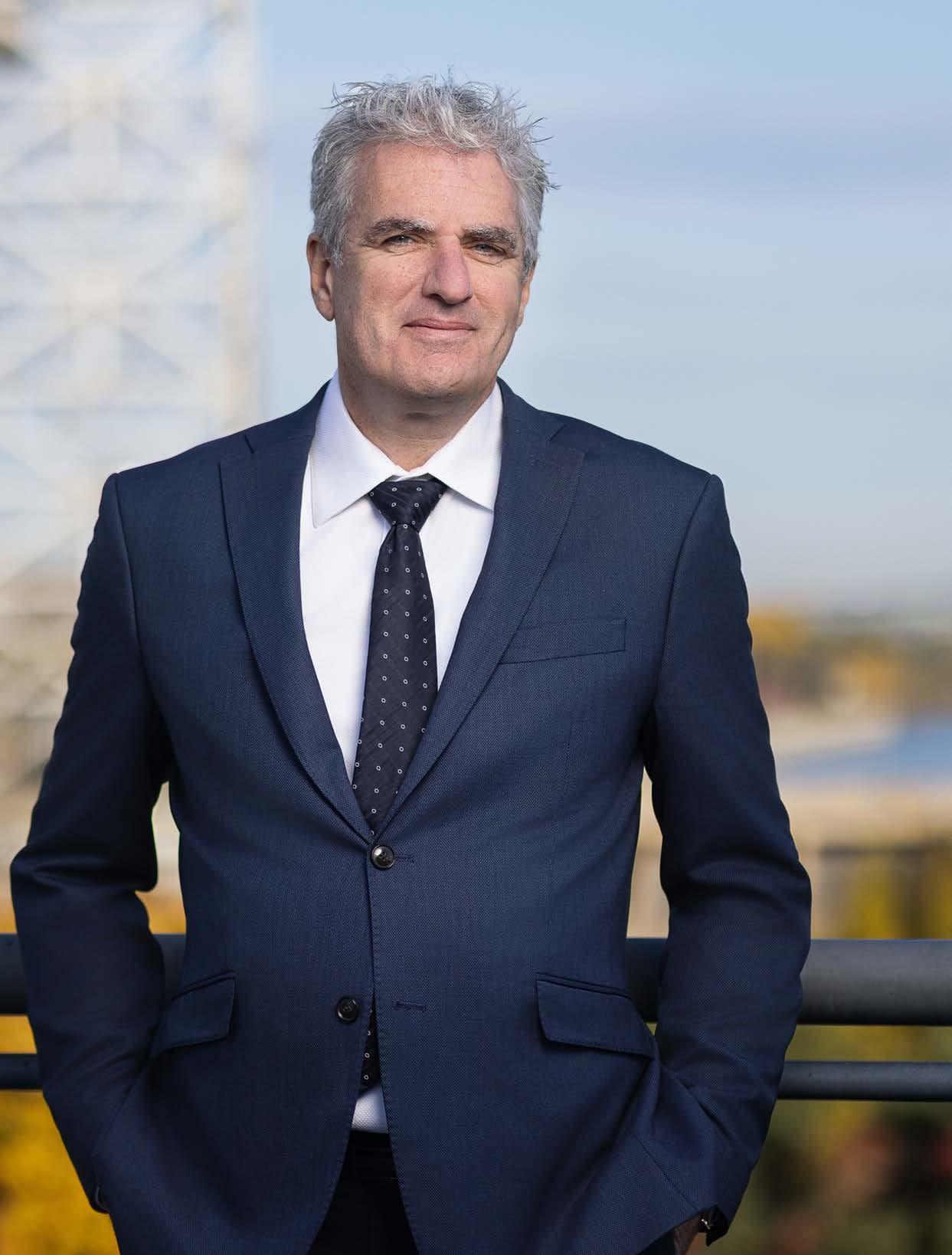
The GLPA operates, maintains and administers a safe and efficient marine pilotage service within designated Canadian waters in the St. Lawrence River and the Great Lakes Region.
commerce
L’APGL exploite, entretien et administre un service de pilotage sûr et efficace dans les eaux canadiennes désignées du fleuve Saint-Laurent et la région des Grands Lacs.

glpa-apgl.com
You took over the helm of the St. Lawrence Seaway Management Corporation mid last year after playing a pivotal role in its modernization for over 16 years. What is your vision for the future growth of this vital North American waterway? What are its most strategic advantages?
The St. Lawrence Seaway plays a central role in keeping goods moving efficiently across North America. My focus is on strengthening that role by positioning the Seaway to handle more capacity, improve reliability, and support the supply chain with modern, dependable infrastructure.
We have the capacity today to move more cargo. By encouraging a shift to marine, we can help take pressure off highways, lower emissions, and support a more sustainable way of moving goods. We’re also continuing to invest in infrastructure and digital tools that will make the system more responsive to customer needs. There’s a real potential for growth, and we’re ready to support it.
How do today’s global economic and geopolitical challenges affect your ability to realize this vision?
Any disruption to trade or the movement of goods is a concern. Tariffs, economic volatility, and geopolitical tensions are all part of the present landscape. We monitor these developments closely and engage with our partners to maintain stability and support users of the system.
What gives me confidence is the strength of our cross-border collaboration. That relationship continues to be a model of cooperation. Especially now, when reliability and resilience are paramount, that alignment is more important than ever.
The Seaway is recognized for leading innovation in the global maritime sector. Can you share an update on the new AI-powered navigation and scheduling platform developed with your U.S. counterparts?
Innovation has always played a key role in how we operate the Seaway and serve our users. The Voyage Information System (VIS) is a great example of that evolution.
Developed with our U.S. counterparts - The Great Lakes St. Lawrence Seaway Development Corporation, this platform supports better planning and coordination across the system. What makes VIS powerful is the willingness of partners to share data, giving all users better visibility and enabling smarter decisions.
VIS brings together information like vessel movements, lock and bridge availability, and weather updates in one place. It also includes forecasting tools that help predict lock schedules more accurately.
It’s another way we’re making the system more responsive and efficient for everyone who relies on it.
Climate change appears to be creating opportunities to extend the navigation season. Could longer seasons apply to both the Montreal–Lake Ontario and Welland Canal sections in the coming years?
Favourable conditions and consistently strong operational performance have allowed us to safely extend the navigation season in recent years. We successfully piloted season extensions in the Welland Canal over several years and in 2024, we extended the season in both Montreal to Lake Ontario and the Welland Canal. This resulted in the longest season on record.
We’re planning to continue to work on further extending the season, building on what we’ve learned. These decisions come from working closely with users and communities, while monitoring the conditions, and making sure we can manage transits safely and reliably. It’s another way we’re helping businesses move goods when it matters most.
Late last year, the Seaway announced a $350 million infrastructure investment. What are the key highlights of that plan?
We launched a three-year, $350 million infrastructure program in 2024 to strengthen the Seaway’s reliability and support future growth. The work includes upgrades across the system and a continued focus on innovation, safety, and long-term performance.
One of the first major milestones was the gate replacement at Lock 7. The spare gates had been built nearly a century ago and stored on the canal bed since the 1930s. That long-term foresight paid off last winter, when our team floated them out, refurbished them, and brought them back into service. It was a complex job and a powerful example of the kind of planning and ingenuity that defines the Seaway’s resilience.
We also advanced the rollout of handsfree mooring (HFM). Preparations at Iroquois Lock began last winter, installation was completed in the spring, and the system became fully operational this summer. The final installation at Lock 8 in the Welland Canal is scheduled for completion in 2026. Once finished, the entire Seaway system will be equipped with this HFM technology - a major step forward in safety, efficiency, and service reliability for all transiting vessels.

THE ST. LAWRENCE SEAWAY PLAYS A CENTRAL ROLE IN KEEPING GOODS MOVING EFFICIENTLY ACROSS NORTH AMERICA. MY FOCUS IS ON STRENGTHENING THAT ROLE BY POSITIONING THE SEAWAY TO HANDLE MORE CAPACITY, IMPROVE RELIABILITY, AND SUPPORT THE SUPPLY CHAIN WITH MODERN, DEPENDABLE INFRASTRUCTURE.
- JIM ATHANASIOU


THROUGHOUT MY CAREER, I’VE MADE IT A PRIORITY TO LISTEN, TO LEARN, AND TO UNDERSTAND WHAT PEOPLE NEED FROM THIS SYSTEM. THOSE CONVERSATIONS OFTEN LEAD TO BETTER IDEAS AND STRONGER PARTNERSHIPS.
- JIM ATHANASIOU

The Seaway has expanded into project cargo and other niche markets. Do you see more diversification ahead?
We continue to see steady demand for traditional cargo like grain, while also seeing growing interest in new types of shipments. More project cargo, wind components, and specialized equipment are moving through the system, which signals that more shippers are recognizing the Seaway as a reliable solution.
There are also opportunities through our real estate holdings. Tenants located along the system are supporting local economies, creating jobs, and contributing to economic development in the communities we serve. This is another way the Seaway delivers value to the communities we’re part of, not just as a transportation route, but as a driver of economic activity.
Throughout your career, stakeholder engagement has been a priority. How do you see this evolving in your role as President?
What sets the Seaway apart is the trust and collaboration built over time with the people and communities connected to it. Whether it’s those who work on the system, live near it, or rely on it for trade and transportation, their perspectives help shape what we do and how we do it.
Throughout my career, I’ve made it a priority to listen, to learn, and to understand what people need from this system. Those conversations often lead to better ideas and stronger
partnerships. I’m continuing that work, finding practical ways to collaborate, and helping the Seaway deliver even more value for people, communities and the North American economy.
The Seaway’s partnership with the United States has been longstanding and successful. With Mike McCoshen, as the new Administrator now leading the Great Lakes St. Lawrence Seaway Development Corporation, how is that relationship evolving?
I’ve had the opportunity to meet with Mike and continue to connect with him regularly. He brings deep experience in the Great Lakes marine industry and is a strong supporter of Seaway trade. Our teams work closely to align our operations of this binational waterway, in order to deliver value to the North American economy.
There has been growing discussion about the Seaway’s potential role in transporting energy products, including LNG. What are your views on this opportunity?
The Seaway is an underutilized corridor with real potential to support the movement of energy products, including LNG, to Europe and other global markets. We believe our strong track record in safety and reliability makes the Seaway well positioned for this type of cargo. It also positions the Seaway to assist the Federal Government in realizing its nation building projects, as well as its goal to build the strongest economy in the G7. n

HARNESS THE GLOBAL POWER OF A GREAT LAKES PORT.
Regional, national and international logisticians count on Port Milwaukee for a turnkey approach to solve their transportation and supply chain needs. Strategically located in the industrial center of the U.S., Port Milwaukee provides premier access to domestic and world markets.
MARINE SHIPPING LEADERS SEEK GOVERNMENT PARTNERSHIP IN REALIZING A BETTER FUTURE
BY JASON CARD
Nearly 100 executives representing ports, shipping lines, rail operators and other stakeholders gathered in Montreal on September 29th to issue a unified call for accelerated investment and modernization of the St. Lawrence–Great Lakes waterway.
The waterway has been presented as North America’s logistical backbone by this “St. Lawrence and Great Lakes Leadership Roundtable,” as they emphasized that it links important manufacturing hubs to international markets and underpins cross-border trade between Canada and the United States. The event organizers included the Chamber of Marine Commerce, the St. Lawrence Economic Development Council, the Ontario Marine Council, the St. Lawrence Shipoperators’ Association and CargoM.

The summit event was co-chaired by The Honourable Jean Charest, The Honourable Lisa Raitt, and Former U.S. Seaway Administrator Adam TindallSchlicht, with discussions leading to a united call for:
• Major and sustained infrastructure investment;
• P olicy and regulatory reform for greater flexibility and modernization;
• Targeted support for workforce development; and
• Stronger cross-border governance mechanisms.
A joint declaration capturing these priorities was presented at the Great Lakes–St. Lawrence Governors &
Premiers summit that followed in Quebec City from from October 4th to 6th, as well as to provincial and federal governments. In addition, the coalition reaffirmed support for a tariff-free trade agreement among Canada, the U.S., and Mexico as part of a broader economic strategy.
Maguessa Morel-Laforce, Senior Director of Government and Stakeholder Relations for the Chamber of Marine Commerce, explained that “improved infrastructure will help the inland and coastal marine shipping industry move more goods in a more sustainable manner, and will enhance North America’s competitiveness amid a shifting trade and environmental landscape.”
“It bears noting that while the 2025 Seaway season began strongly — moving more than 4.5 million tonnes of cargo by April — the potential for future growth could be constrained by aging infrastructure and regulatory bottlenecks if we do not have full partnership from federal, provincial, and state governments,” he added. “We look forward to see meaningful responses and increased investment and engagement in the months and years ahead, as we all share the same vision of building economic strength and global competitive advantage.” n



On September 3rd, the mayors of key Great Lakes and St. Lawrence port cities called on the Government of Canada to allow foreign containers to be processed at more Canadian ports across the Great Lakes and St. Lawrence Seaway corridor. The Chamber of Marine Commerce Interviewed the Mayor of St. Catharines, Mat Siscoe, to discuss this call to action.
INTERVIEW BY JASON CARD
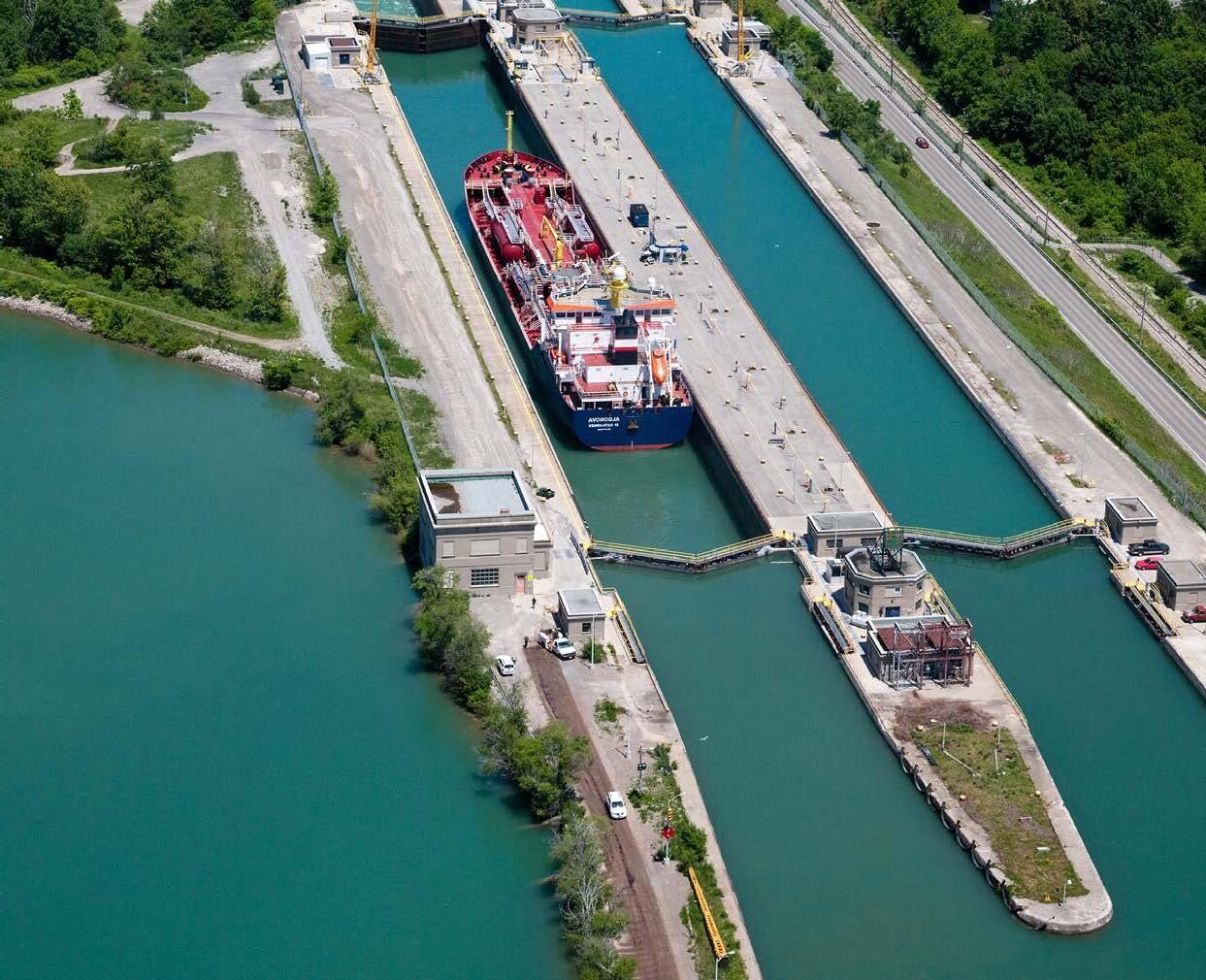
Thank you for agreeing to speak with us, Mayor Siscoe. To begin, can you explain the recent call by the Great Lakes & St. Lawrence Cities Initiative (GLSL Cities) for expanded Canada Border Services Agency (CBSA) support at ports?
Absolutely. The GLSL Cities Initiative — a coalition of municipal and Indigenous governments in the Great Lakes–St. Lawrence basin — has formally urged the federal government to boost and reallocate CBSA resources so that more ports along the Great Lakes and St. Lawrence can host on-site customs and container-scanning services. In effect, the ask is this: enable more Canadian ports beyond Montreal to
receive, inspect, and clear international containers directly. This involves staffing, equipment, and jurisdictional flexibility so that marine gateways don’t remain bottlenecked by customs constraints.
Why is this expansion so important for Canada’s economy and for marine trade?
There are several reasons. First, Canadian coastal and inland ports currently lack the full customs infrastructure that many U.S. ports enjoy; as a result, containers arriving at Canadian ports often must first land in the U.S. and then be trucked back across the border. That’s less efficient, shifts economic activity south, adds
cost and emissions, and undermines Canada’s trade competitiveness. The GLSL Cities letter underscores that stronger CBSA facilitation capacity is a necessary complement to Canada’s trade diversification agenda.
Second, by enabling inland marine gateways to handle container traffic, we can relieve pressure on rail and road corridors, reduce congestion, and lower greenhouse gas emissions—because per-tonne-kilometres, vessels are far more carbon efficient. The GLSL coalition frames this as central to making Canada the strongest economy in the G7.



What challenges must be overcome for this to become reality?
There has to be a shift in approach at the CBSA. The CBSA has traditionally emphasized its security and enforcement mission. Shifting to a more facilitative posture requires cultural change, additional staff, and perhaps legislative or policy mandates to empower on-water ports.
How do you see St. Catharines and the Niagara region playing a role in this agenda?
St. Catharines is situated strategically along the Welland Canal and Lake Ontario. If CBSA support were expanded, our port facilities could more readily participate in containerized trade flows—benefiting local industry, creating jobs, and contributing to supply-chain
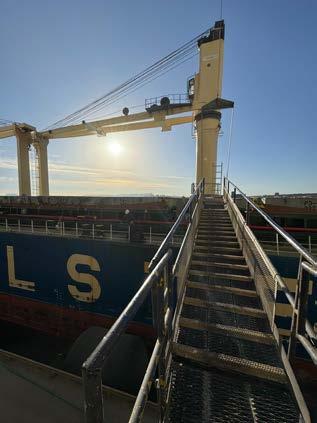

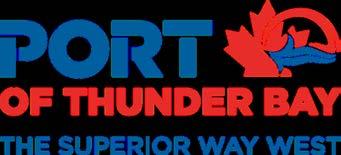

resilience. We are eager to work with our provincial and federal partners, as well as with GLSL Cities and industry stakeholders, to pilot CBSA-enabled container handling at our facilities.
Finally, what message would you like federal policymakers to take away?
The message is clear: the customs barrier is not a small detail—it’s a gatekeeper to economic opportunity. If Canada is serious about doubling trade, strengthening sovereignty, and leading as a resilient economy, we must empower CBSA in inland waterways, not only at border crossings. The infrastructure, the environmental benefits, and the industrial competitiveness all argue strongly for this move. The time to act is now.






THE PORT OF JOHNSTOWN BUILDS ON A STRONG BUSINESS FOUNDATION WITH A NEW GENERAL MANAGER
BY JULIE GEDEON
Leslie Drynan, the new General Manager at the Port of Johnstown, is often found at the docks or in the shop with the frontline workers. “These gentlemen – they’re all men at this point – have years of experience and insight about the port’s operations,” she says. “So I put on my workboots and the appropriate jacket for the weather and spend time with them, whether they’re sweeping up or greeting a trucker, so I can learn why they do things a certain way,” she says. She also eats lunch with them as often as possible. “It’s important to involve them in decision making whenever we’re thinking of changing any process or planning new capital projects,” she says. “They share the good, bad, and ugly that happens daily, which I appreciate.” Drynan regards each of them as valued members of the port and the community it serves. “Employing unionized workers doesn’t necessitate having an ‘us versus them’ mentality,” she emphasizes. “We’re on the same team with mutual goals
to sustainably build our community’s prosperity through our port operations.”
Established in the early 1930s, the Seaway port 100 kilometres (62 miles) south of Ottawa has become one of Eastern Ontario’s leading transit points for vessel, truck and rail shipping of grain, salt, aggregates and project cargo. The Township of Edwardsburgh Cardinal purchased it from Ports Canada in 2000 and changed its name in 2014 from Prescott to the Port of Johnstown, the same as the town where it’s located.
Hired in October 2024, Drynan fully took over as general manager in January upon Robert Dalley’s retirement from the position after 16 years. He continues to work remotely in a part-time advisory and project management role this year.
With the port well positioned for growth based on Dalley’s strengths in business and supply chain logistics, the township sought a general manager with more governance experience. “While the port’s management committee includes all of
the township council, it was operating separately from the township,” Drynan explains. “The council wants a greater integration in terms of collaboration, transparency and accountability so that the port functions more along the lines of a municipal department.”
After dedicating most of her career to municipal government with a focus on building healthy and resilient communities, Drynan was quietly seeking a change that would put her transferable knowledge, skills and experience to new challenges. Born and raised in Eastern Ontario, she was familiar with the township, having worked at a municipality just down the road from the port, but hadn’t thought of applying there.
“I’d heard about Mr. Dalley’s impending retirement but really knew nothing about the port,” she relates. “So I attended Port Day in June 2024 and just quietly took in all the activity, along with the opportunity to chat with two long-term

employees who were at the gate that day, and I left feeling inspired, like I could make a change at the port.”
Drynan subsequently researched the port’s website, minutes, and other maritime information. “I’d had earlier success working with a public works department and a fire department related to positive organizational change, internal promotions and workplace culture development, and here was another chance to work in a blue-collar environment at a time when the township was looking to make key changes.”
The integration is to better inform residents about the port’s benefits to their community. “The port is not funded by any tax levy whatsoever,” Drynan notes. “It’s self-sustaining and gives back approximately $1.5 million to $2 million in surplus revenue to the township annually towards capital infrastructure improvements, and we are in the process of developing further surplus sharing and inventory management policies.”
Port revenues have kept tax rates from rising. Drynan hopes future surplus will go to some capital programs which residents will associate with the port’s
value. “Whether its paving certain roads or building a hockey rink, it would be good for the community to know how the port is improving the community.”
Drynan’s first priorities have included devising a strategic plan with the assistance of the consultant who prepared the township’s strategic plan two years ago. “We’ve been involving our leadership team, frontline workers, customers, partners and other stakeholders, as well as the community, in this process over a six-month period,” Drynan shares. “The plan will establish what we’d like to see over five years.”
To date, investments have largely been in response to market demands. “When we found ourselves with lots of wet corn, for example, we invested in a grain dryer,” Drynan says. “We now want to look at what our farmers, brokers and residents want to see in terms of long-term capital planning, as well as the money required, while still generating a surplus.”
With her mohawk hairstyle and elaborate nails, Drynan defies managerial stereotypes. “I realize I’m not what people typically envision but, to be my
real self, I’ve had to work harder and have developed an internal drive to prove myself,” she says. “I want everyone to be their true selves at work and they can’t be if I’m not.”
Her genuine interest to listen to and learn from others come across immediately. So does her passion to figure out with others how to make things work as smoothly as possible. “I came here with no idea how to operate or repair a grain elevator, so it’s essential for me to involve the people who do.”
The port has a small workforce. The 24 full-time employees include seven on the leadership team and 17 on the front lines. Drynan expects to have a clearer vision of the port’s future labour needs when the strategic plan is completed. “It’s difficult at this point to compete with the executive salaries of larger ports, but we compare favourably with local industry and treat our employees well.”
Prior to the Seaway’s opening, Drynan focused on operational and capital budgets and learnt the ins and outs of each position as part of the pay equity and compensation review to ensure they comply with all federal legislation. “We’ve also updated our workplace accessibility requirements and made all of our employees aware of municipal, provincial and federal requirements,” she adds.
Drynan commends the Chamber of Marine Commerce for being among the first organizations to reach out after she was hired. “Two weeks later I went to the Highway H20 conference where I met so many people and learnt so much,” she says. “The CMC team has been fantastic from a support and networking standpoint,” she says. “I love the daily news bulletins, and the team is a call away if I need additional information or support on any issue.”
She plans to dovetail with CMC’s resources as the port updates its social media presence. “I’m eager to showcase what each member of our team does for the port,” she says.
Her overall enthusiasm for her new role abounds. “I wake up excited to go to work,” she says. n
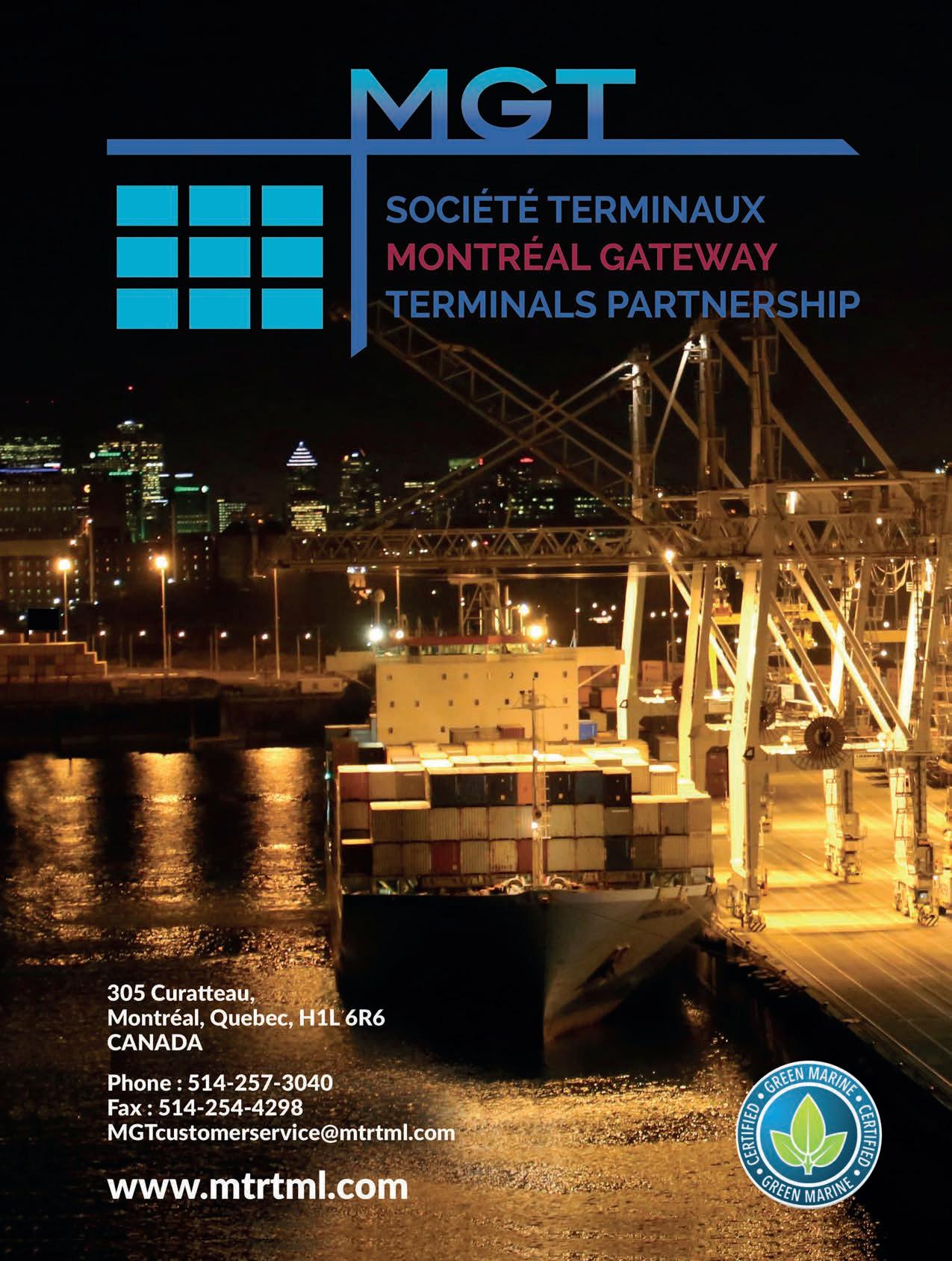

BY LEO RYAN
Agrowing worldwide trend is seeing more and more individual ports forging cooperation agreements with foreign or regional partners to enhance trade, foster innovation and promote green shipping corridors. Such agreements include creating competitive supply chains, fighting drug trafficking and facilitating low-emissions in port operations. And Canadian ports, arguably at least partly inspired by developments initiated in European maritime centres, don’t intend to be left behind as various strategic alliances emerge.
In the above context, worth following closely has been the expansion since October 2024 of the cooperation agreement of five ports to reinforce the St. Lawrence - Saguenay Marine Corridor as a key North American gateway. The ports of Saguenay, Quebec, Trois-Rivières, Montreal, and Sept-Îles – which handle total traffic of 103 million metric tonnes - are leveraging their collective strengths to optimize operations, sustainability, and commercial reach. While Montreal is currently the sole container port on the St. Lawrence, the other partners mainly focus on bulk shipments.
In a statement e-mailed to Marine Delivers following discussions this past summer, the CEOs of the five ports emphasized the significance of their alliance: “The St. Lawrence - Saguenay Marine Corridor is more than a logistical corridor, it is a strategic bridge to global

markets. Our collective commitment enhances not only our resilience but also our capacity to support Canadian businesses in accessing new markets. Together, we are setting the standard for efficient, sustainable, and competitive maritime trade.”
The statement affirms that the unified approach is accelerating infrastructure projects, such as green logistics zones, electrification of terminals, and real-time data platforms.
“These initiatives are designed to meet the growing demands for sustainable and efficient trade, while also reinforcing the region’s reputation as a competitive and eco-friendly maritime corridor,” the statement explains, adding: “The five-port collaboration serves as a blueprint for the future of maritime commerce, driving economic diversification and sustainable development for Quebec and Canada as a whole.”
In a number of speeches to industry audiences, Julie Gascon, President and CEO of the Montreal Port Authority, has urged all stakeholders to mobilize behind the St. Lawrence/Great Lakes maritime corridor.
And during an interview with this observer, Gascon noted: “We are very complementary, we don’t compete against each other. Sept-Îles, for instance, specializes in iron pellets and can accommodate the largest bulk vessels in the world. Saguenay has lots of logistics infrastructure, heavy machinery, and lots of land. Montreal, Trois-Rivières, and Quebec don’t necessarily compete against each other. We work better together in terms of technology, looking at how we can share best practices.”
At the same time, Gascon also acknowledged: “There are limitations to the collaboration due to the Competition Act framework. It would be great to push collaboration further in strategic planning.”
Significantly enough, the same group of five St. Lawrence ports have signed a Memorandum of Understanding with North Sea Port in Northwest Europe. The latter is a cross-border area stretching between Vlissingen on the North Sea in the Netherlands and Ghent in Belgium.
“Canada is North Sea Port’s fourth most important trading partner in terms of cargo throughput,” says Maarten den Dekker, Chief Sustainability and Digital Officer of North Sea Port. “Our location in Western Europe is of great strategic importance for cooperation with the ports of Montreal, Quebec, Saguenay,
Sept-Îles and Trois-Rivières. Cooperation with these five Canadian ports can only be beneficial.”
The establishment of green shipping corridors figures highly in a cooperation agreement renewed this year between the ports of Montreal and Antwerp, as well as in an agreement between the ports of Halifax and Hamburg.
Halifax is also home to “THE PIER,” Canada’s first living lab dedicated to transportation, supply chain and logistics industries. Created in 2023 by the ports of Halifax (THE PIER), Hamburg and Valencia, the Port Innovators Network (PIN) recently expanded to South America by welcoming Brazil’s Cubo Maritime & Port as a new member.
In other developments, the ports of Vancouver and Hamburg have concluded a cooperation agreement. “Since signing an MOU last fall, both port authorities have leveraged their longstanding history of collaboration to advance shared priorities in maritime decarbonization, safety, digital innovation, and sustainable cruise operations,” comments Capt. Shri Madiwal, Vice-President of Operations and Supply Chain at the Vancouver Fraser Port Authority.
Concerning cooperation between European ports, a major initiative was the founding in 2024 of the European Ports Alliance and its Public Private Partnership. A leading priority has been to fight drug trafficking and organized crime. Measures to improve security in European Union ports include 200 million
euros for funding modern equipment to help customs authorities scan containers and check imports more efficiently.
Meanwhile, Latvia’s Port of Riga has captured attention by taking initiatives to promote the interests of mediumsized European ports which have fewer resources than their bigger brothers.
The port is a founding member of the Association of Four Sea Ports with Cartagena in Spain, Trieste and Monfalcone in Italy and ports along the North Sea in Belgium and the Netherlands. Of special interest is the fact that the Port of Riga has joined a consortium of Latvia, the U.K. and Canada in a project to develop a test facility – known as the Remote Operations and Control (ROC) platform - for autonomous marine operations. The lead partner is U.K. maritime innovation company On The Layline Limited. The Canadian partners are the Fisheries and Marine Institute of Memorial University and Angler Solutions of St. John’s.
“The next generation of shipping and port technologies is rapidly evolving, primarily focused on the development and integration of various autonomous operating systems,” asserts Rob Watson from On The Layline, the British firm specializing in the energy and ocean technology sectors. n

Earl Provost, Agent-General with the Ontario government’s Trade and Investment Office in Chicago, is keen to help companies to start, maintain or increase business with Americans in the Great Lakes region and beyond. He assists Ontario enterprises in networking with stakeholders in Illinois, Indiana, Iowa, Kentucky, Michigan, Minnesota, Missouri, Nebraska, North Dakota, Ohio, South Dakota, and Wisconsin. He likewise helps American enterprises that want to expand into Ontario. The offer of help comes with him knowing there are challenges with new and still possible tariffs.
Column Provided by Earl Provost

As part of Premier Doug Ford’s vision for greater Ontario-U.S. engagement, I was appointed as the first agent-general with one of Ontario’s now several Trade and Investment Offices in 2020. Based in Chicago, my region encompasses the Great Lakes where a minimum of US$140 billion is done in trade between the U.S. and Ontario yearly, and that’s a conservative number. Other estimates range from US$150 billion to US$170 billion annually. Trade between the U.S. Great Lakes states and Ontario remains robust with established relationships and great potential.
My job is to build strong working relationships with key stakeholders. In Ontario, I continually work on this goal with the Chamber of Marine Commerce, and the Ontario Marine Council. Our office has also signed economic Memorandums of Understanding (MoUs) with Michigan, Indiana, and Illinois. We expect to sign MoUs with others based on the interest in discussing future joint economic opportunities.
Premier Ford says things get done when people know each other. These MoUs establish the structure to start us talking. We’re encouraging Ontario’s elected officials to speak with the elected officials in each state, but also with the representatives of all chambers of commerce. Most people understand the Great Lakes regional economy’s importance and the opportunities it presents.
The Canadian government also has honorary consuls-general in Missouri, Ohio, North Dakota, and Iowa, and my office collaborates with them regularly to build relationships. A key component is removing unnecessary hindrances to cross-border trade. Our mission is to make it as easy as possible to move product in and out of Ontario.

Premier Ford strongly supports a “Team Canada” approach. The three Canadian consulates in Detroit, Chicago and Minneapolis within my territory are a big reason for a lot of my success in establishing new trade avenues. Quebec and Alberta also have offices in Chicago, and we often compare notes and help each other out.
A lot of my job in helping Ontario businesses in the States and U.S. firms to expand into Ontario involves connecting individuals to the right people and resources within the Ontario government. Premier Ford is pro-business. He’s passionate about helping Ontario companies to succeed because that creates more jobs for Ontarians.
We have an infrastructure, network and resources to help Ontario stakeholders to navigate the business world south of the border. We’ve built good relationships with financial institutions and economic developers on both sides of the border, and we often have municipal and regional contacts who can help to make a project happen.
I also support key advocacy efforts. With the tariff situation, we’ll likely see more provinces set up operations in the United States. For example, Manitoba opened a Washington, D.C., office in June. However, the work isn’t done just in D.C. It must take place at the regional, state and local level, building relationships with Republicans and Democrats, along with key economic stakeholders.
It’s a huge investment but pays off. I was the first of Ontario’s agents-general with my new post in Chicago. Ontario has since appointed agents-general in Dallas, in addition to having Ontario’s representative in Washington, D.C.
Premier Ford remains excited to foster collaboration among Great Lakes ports to establish a green supply chain, and he’s keen to see marine facilities continue to be upgraded and improved. He’s excited about the potential, even with tariffs. After all, Ontario offers solid and reliable business relationships, a talented workforce, and dependable marine, rail and trucking networks and,
of course, a more affordable Canadian dollar. I attend the Annual Private Label Trade Show in Chicago every November where Ontario has a huge presence with food and other producers because American buyers know these companies will deliver quality products on time.
MY JOB IS TO BUILD STRONG WORKING RELATIONSHIPS WITH KEY STAKEHOLDERS.
IN ONTARIO, I CONTINUALLY WORK ON THIS GOAL WITH THE CHAMBER OF MARINE COMMERCE, AND THE ONTARIO MARINE COUNCIL.
- EARL PROVOST
This isn’t the first time we’ve had trade differences. From 1972 to 1984, the Pierre Trudeau government worked towards less reliance on trade with the U.S. in favour of expanding markets in Southeast Asia, Western Europe and elsewhere and that worked well for many years. After Brian Mulroney was elected, Canadians took a leap of faith in establishing a free-trade agreement with the U.S. in 1988 that worked well through the presidencies of George H.W. Bush, Bill Clinton, George W. Bush, Barack Obama, Donald Trump’s first administration, and Joe Biden. We’re hopeful that negotiations with the current Trump administration will make free trade work again, but the Government of Ontario is also preparing to pursue other options.
Most elected officials – Republicans and Democrats – realize what’s at risk, especially in the border states. Trade between Ontario and Michigan alone is approximately US$70 billion annually. And it’s not just the auto sector… Ohio will lose many jobs if tariffs continue.
President Trump has some legitimate concerns. A country needs to maintain its ability to produce steel and aluminum. He also wants more balanced trade with countries. But let’s address the issues as was done during his first administration. When the U.S raised concerns about steel being dumped into the Canadian marketplace, those concerns were addressed.
Premier Ford is bullish about promoting the advantages of doing business with Ontario. We have reliable transportation infrastructure, a skilled workforce and significant resources that are in high demand. Ontario also presents a huge market to our U.S. neighbours.
So I’m here on behalf of Ontario to help companies and individuals to find the ways to start, maintain or expand business in Ontario and in the United States. It starts with sending me a message on LinkedIn or calling the Ontario Trade Investment Office in Chicago at 1 773-703-5151. n

BY DOUG PORTER, CHIEF ECONOMIST AT BMO FINANCIAL GROUP

DOUG PORTER CHIEF ECONOMIST, BMO
Heading into 2026, the North American economy is adjusting to a somewhat calmer trade battlefield, and both Canada and the U.S. are showing signs of resilience and even recovery. Each economy will get a boost from expansionary fiscal policies and renewed monetary policy easing. But it’s not all clear sailing, with the biggest risks stemming from somewhat sticky inflation, and a possible escalation of the trade war pending the upcoming USMCA renegotiation.
On balance, tariffs have caused some ‘stag’ and a little ‘flation’, but less of both than many economists initially feared. Make no mistake, North American growth has slowed in the past year. U.S. average real GDP cooled to just under 2% in 2025 from almost 3% the prior year, but close to the economy’s long-run potential rate of about 1.8%. Private domestic demand has provided the backbone, led by strength in business fixed investment. Technology companies are spending massively to build AI infrastructure,
while other companies are investing heavily to adopt AI systems. Propelling consumers, especially in the higher income brackets, is a powerful wealth effect from record-setting equity markets. Overall, we now expect another year of modest U.S. economic growth in 2026 of just under 2%.
Aside from ongoing federal government cutbacks, there are two soft patches in the U.S. economy—housing and the job market. Housing has struggled ever since the Fed began tightening policy in 2022, driving mortgage rates to multi-decade highs. However, a recent easing in borrowing costs will help. The more significant weak spot is employment. Job gains have cooled notably, albeit the picture has been clouded by the government shutdown. Some of the slowdown stems from deportations, which are slowing workforce growth, and AI, which is making managers think twice about hiring.
For these reasons, the Fed now believes downside employment risks outweigh upside inflation threats, prompting it to start cutting rates again. With the federal funds target rate still modestly restrictive at around 4%, there’s more easing to come. We expect follow-up moves in the year ahead, and look for the overnight rate to eventually drop below 3% by the end of 2026.
The worst may be over for the Canadian economy. After contracting in Q2 due to deep declines in goods exports and machinery investment at the height of the trade uncertainty, real GDP turned modestly higher in Q3. Barring a re-escalation of the trade war, both exports and investment should stabilize. With plenty of fiscal stimulus in the works (details in the November 4 federal budget), and the
central bank staying on the easing path, growth should improve in the coming quarters.
Households are cushioning the blow from tariffs aimed at the auto, steel and aluminum industries. Consumer spending managed to strengthen in 2025 despite the many negative headlines around trade, boosted by strong domestic travel trends. With Canadian southbound visits down roughly 30% this past year, billions of dollars have been redirected toward domestic tourism (which accounts for 1.3% of GDP). A sizzling TSX has lent a hand.
As in the U.S., Canada’s housing and labour markets are weak links. However, improving affordability due to softer home prices should lead to a modest recovery in the year ahead. Meanwhile, a rising jobless rate is concerning. Still, with the economy expected to strengthen, the unemployment rate should rise only slightly further to a bit above 7%, before declining late next year.
The softer job market prompted the Bank of Canada’s attention to resume lowering policy rates in September, despite underlying inflation still hovering moderately above the 2% target. We look for the Bank to eventually bring the policy rate to 2.0% in early 2026.
The biggest risk facing the economy is if the U.S. walks away from the USMCA, causing Canadian exporters to lose the current exemption on compliant goods. In this event, the economy would likely slide into recession. Consultations between the U.S. government and businesses have begun and hopefully will underscore that re-signing the free trade agreement, even with modifications, is in the best interests of all three countries. n
For over 100 years, Oceanex has been providing efficient and reliable intermodal transportation services safely and with environmental leadership. With our fleet of 3 vessels and the largest dedicated fleet of containers and trailers servicing the province of Newfoundland and Labrador, we keep retail shelves stocked and deliver the materials that build and support our communities, keeping the economic engines of the province running.

Full Load
A custom fleet to meet any requirement

Automotive
Purpose built vessels

Project Cargo
Experienced professionals, dedicated technology

LTL
No load is too small for Oceanex

International Cargo

Oceanex
Global Logistics

To and From Anywhere. Oceanex can help you move what matters.
www.oceanex.com





















